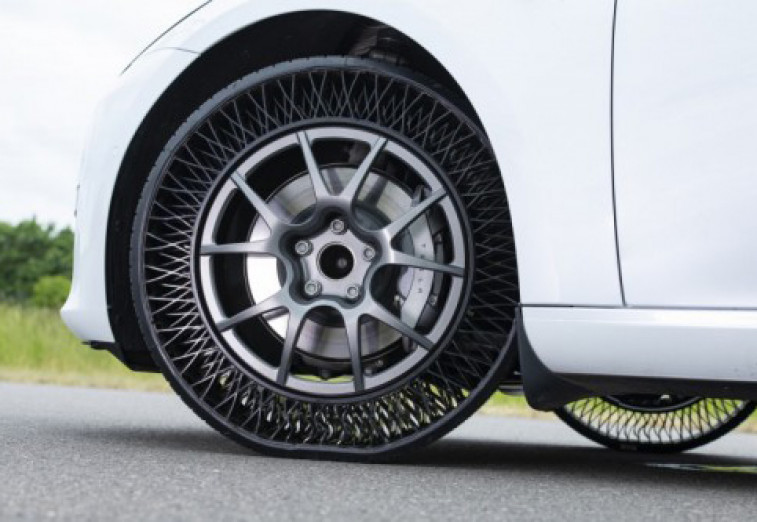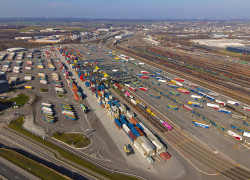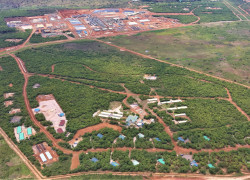Goodyear reimagines the tire for multi-modal future
The mobility landscape is changing and we're entering a new era in the way we move. With car-sharing schemes, autonomous vehicles, and alternative fuels providing solutions across a range of different scenarios, a lot of things will change in the coming years.
Goodyear is responding to these changes to usher in a new era of how we move. As transport is being reimagined, it's time for tires to be reimagined in a similar way. This is why Goodyear is developing an airless that will support a future of multi-modal transport while improving sustainability.
While air-filled tires will always have their place, a mixture of solutions is needed across different applications. Autonomous vehicles, for example, may benefit from the maintenance-free aspect of an airless tires, while other vehicles may still favor the traditional tire.
What are non-pneumatic tires? Put simply, a non-pneumatic tire is any tire that doesn't use air, which is why they're often called airless tires. Goodyear's non-pneumatic tires are made from three components: the shearband (including the tread), connecting web, and the wheel. It's the connecting web that makes all the difference here, as it's this structure in combination with the shearband that supports the weight of the vehicle and gives the tire a compliant feel.
Michael Rachita, Goodyear's Senior Program Manager for non-pneumatic tires explains: “A non-pneumatic tire, in this case, is an engineered structure — it's not a solid design, though any airless tire counts as non-pneumatic. Imagine the wheel on a train, it's steel and heavy, that is a non-pneumatic tire. Or you could have a rubber doughnut driving a wooden wagon wheel, this is another type of non-pneumatic tire.
“What we have engineered, however, is a specifically designed architecture that allows tensioning and hanging of the vehicle's weight from the top. You need this to get the nice soft, compliant feel like you have in an air-filled tire."
Advantages of airless tires There are several advantages to airless tires, these include:
- Maintenance-free operation
- Increased comfort with heavy loads
- Reliability
As we move into a world where autonomous vehicles are becoming more common and many cities are offering transport-as-a-service (TaaS) strategies, having a maintenance-free tire is hugely important. There's no need to check pressures on a set of airless tires, which eliminates the need for regular monitoring. On top of this, the structure of Goodyear's non-pneumatic tire means that a vehicle can keep running — even when something goes wrong.
“Redundancies are important," says Rachita. “Take autonomous shuttles, for example, they have LiDAR and they have GPS, if either of those were to fail, they have optical cameras to fall back on. This means there are a number of backup systems to make sure the vehicle can perform well. When a tire is based on air pressure, the tire has no backups. If you were to get a rapid loss of air or have an integrity issue with the tire, the vehicle stops and can't continue to work."
A non-pneumatic tire, however, does have these fail-safes. Because of the connecting web structure, the tire can still operate as normal, even if something happens to it. Rachita explains: “The airless structure means we can lose a number of the connecting elements and it can continue for many, many miles without any concern."
Passenger comfort is also important and while some might assume an airless tire would offer a harsher ride, that's actually not the case. “One area where airless tires have an advantage is comfort," says Rachita, “you actually can carry more load with a more compliant feel than you do in an air tire."
What is driving this innovation? The driving force behind these innovations is Goodyear's vision of a sustainable future that features multi-modal forms of transport where different vehicles coexist together. While air-pressure tires aren't going away any time soon, an airless model presents a range of new opportunities. With transport rapidly changing in this way, technological innovation needs to go into other elements of the vehicle, including tires.
With traditional car ownership, shared mobility services, and autonomous vehicles all potentially sharing the road together, airless tires can increase uptime, performance, and comfort. Just like autonomous shuttles operating within a small, specific area — such as a city center — Goodyear has designed its airless tires to fit a specific need.
“Increasing performance for the mobility space drives uptime, meaning the fleets are always in motion," says Rachita.
While uptime is important, it's not the only area that's driving Goodyear's efforts with nonpneumatic tires. “There's a sustainability aspect too," Rachita continues. “It's not simply around performance. Unfortunately, many conventional tires are removed from service early in their life for things like a puncture, or for issues that could've been prevented — such as under-inflation, where the air pressure wasn't managed correctly."
Non-pneumatic tires, however, won't be removed from service for these issues, reducing the waste stream associated with tires.
The development process Goodyear is aiming for DOT-approved applications for this technology but this is still several years away as the company works through more technical iterations of its airless tires. Trials of the tires on autonomous vehicles and last-mile delivery robots give Goodyear the chance to continually innovate when it comes to construction, materials, and manufacturing processes. As the e-mobility space evolves and multi-modal transport types become yet more common, this offers the chance to test the tires in all-new environments too.
“The non-pneumatic tire development effort at Goodyear is wrapped under a technology bold goal to produce the first 100% sustainable material and maintenance-free tire on the market by 2030," explains Rachita. While pneumatic tires will still play a significant role in the future, designing new tires for specific mobility applications is the next stage for the automotive industry. Goodyear's airless tires will provide a sustainable solution that will help shape how we move in the future.
Communiqués liés
RSA launches technology and management liability insurance s...
RSA Luxembourg, part of Intact Insurance Specialty Solutions, today announces th...
Lancement d'une nouvelle connexion intermodale entre Bettemb...
CFL multimodal a le plaisir d'annoncer le lancement de sa nouvelle connexion i...
Experts from LUNEX award first micro-credentials in Rwanda o...
The Rwanda Ministry of Education (MINEDUC) formally inaugurated Syllabi, a publi...
ERG Notes that ENRC Secures Landmark Victory as Court of App...
Eurasian Resources Group (ERG), a leading diversified natural resources group he...
LetzToken et La Vie est Belle annoncent leur partenariat ouv...
«?LetzToken?», plateforme de tokenisation pionnière basée à Luxembourg, et ...
ERG announces a Pre-Export Finance Facility Agreement based ...
Eurasian Resources Group (“ERG”, “The Group”), a leading diversified nat...
Il n'y a aucun résultat pour votre recherche







